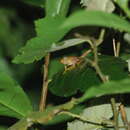Description
provided by AmphibiaWeb articles
M 26-32 mm, F 37 mm. Tibiotarsal articulation reaches at least the eye, sometimes beyond snout tip. Hand with some webbing, foot webbing 1(0), 2i(1), 2e(0), 3i(1), 3e(0), 4i/e(1.5), 5(0.5). Dorsal skin smooth. Dorsally beige, orange or reddish brown, with numerous small reddish spots and a large dark hourglass marking. Ventrally whitish. Males with indistinct nuptial pads and a moderately distensible single subgular vocal sac. Similar species: The colour of B. pyrrhus allows a relatively unambiguous identification. The species most closely related is B. haematopus which can be distinguished by its red colour on limbs.Taken with permission from Glaw and Vences (2007).
Andreone, F. Vences, M. Glaw, F., and Vallan, D. (2008). Boophis pyrrhus. In: IUCN 2008. 2008 IUCN Red List of Threatened Species. www.iucnredlist.org. Downloaded on 07 April 2009.
- author
- Miguel Vences
- author
- Frank Glaw
Distribution and Habitat
provided by AmphibiaWeb articles
Central-eastern Madagascar: An’Ala, Andasibe, Ankeniheny, Mananara, Manombo, Mantadia, near Ifanadiana, Vevembe. Observed between 450-915 m asl. Found in rainforest and secondary vegetation along streams, ditches and swamps with slowly flowing water (Andreone et al. 2008).
- author
- Miguel Vences
- author
- Frank Glaw
Life History, Abundance, Activity, and Special Behaviors
provided by AmphibiaWeb articles
Habits: Males call at night from perches 1-2 m high in the vegetation. Eggs are of blackish colour. Calls: A series of 12-17 unharmonious notes of high-pitched “metallic” sound, getting more intense towards the end of the call. The call is very typical and can only be mistaken with those of B. haematopus and Guibemantis liber.
- author
- Miguel Vences
- author
- Frank Glaw
Life History, Abundance, Activity, and Special Behaviors
provided by AmphibiaWeb articles
Locally common but decreasing. Can tolerate degraded habitat if it is near pristine rainforest, but has not been found in open areas. Habitat is being lost due to subsistence agriculture, grazing, logging, charcoal manufacture, and expanding human settlement. This species is known to occur in the Parc National de Ranomafana, the Réserve Spéciale d’Ambatovaky, and is thought likely to be present in other protected areas as well (Andreone et al. 2008).
- author
- Miguel Vences
- author
- Frank Glaw
Boophis pyrrhus
provided by wikipedia EN
- license
- cc-by-sa-3.0
- copyright
- Wikipedia authors and editors
Boophis pyrrhus: Brief Summary
provided by wikipedia EN
Boophis pyrrhus is a species of frog in the family Mantellidae.
It is endemic to Madagascar. Its natural habitats are subtropical or tropical moist lowland forests, rivers, and heavily degraded former forest. It is threatened by habitat loss.
- license
- cc-by-sa-3.0
- copyright
- Wikipedia authors and editors

